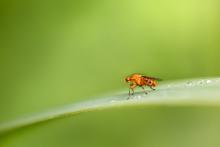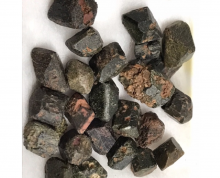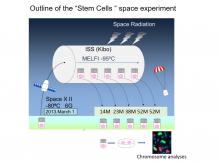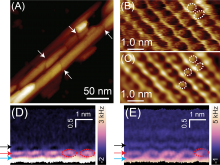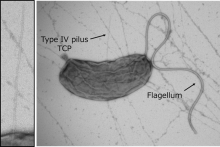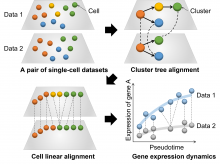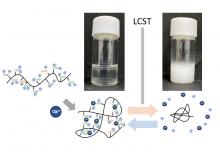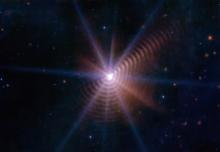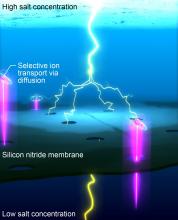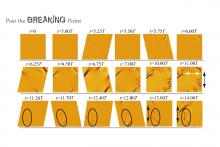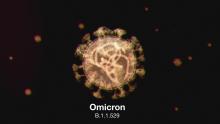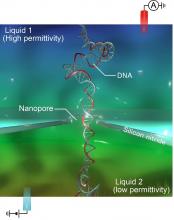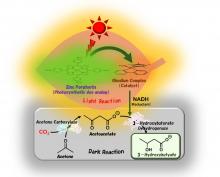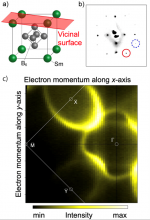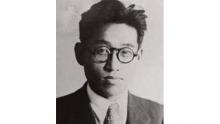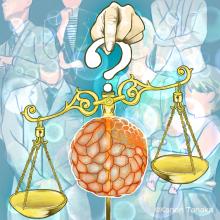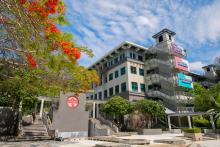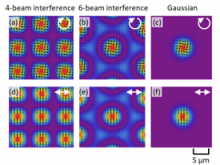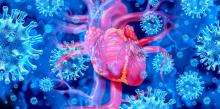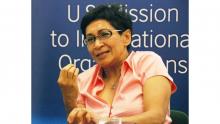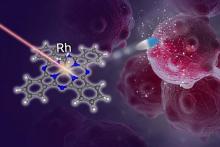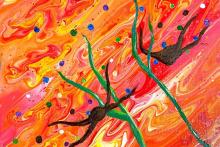Science
News
19 Oct 2022
Scientists have uncovered new details of how ice forming below the ocean surface in Antarctica provides cold dense water that sinks to the seabed in an important aspect of global water circulation.
19 Oct 2022
Pyroxenes are a major group of rock-forming minerals. Osaka Metropolitan University scientists investigated the iron ion status of a calcium-rich pyroxene, using Mössbauer spectroscopy on thin sections of single crystals. The study revealed that in pyroxene crystals consisting of roughly 50% calcium, the tensor that determines the ratios of iron ions at the Mössbauer spectral peaks in the M1 sites—one of two types of cation positions in the pyroxene crystal structure—is independent of the iron content but dependent on the calcium content. The research findings have clarified one of the physical properties of pyroxenes, facilitating detailed future analysis of iron using Mössbauer spectroscopy on mineral flakes.
17 Oct 2022
A long-term experiment aboard the International Space Station has tested the effect of space radiation on mouse embryonic stem cells. Their findings will contribute to helping scientists better assess the safety and risks related to space radiation for future human space flights. The findings are published in the journal Heliyon.
17 Oct 2022
Chemists in Japan, Canada and Europe have uncovered flaws in the surface structure of cellulose nanocrystals—an important step toward deconstructing cellulose to produce renewable nano-materials relevant to biochemical products, energy solutions, and biofuels.
14 Oct 2022
Researchers from Osaka University have found that the Vibrio cholerae colonization factor TcpF forms a flower-shaped trimer to specifically bind to the minor pilus protein TcpB resulting in secretion by the type 4 pilus secretion system into the extracellular space. This finding could help lead to the development of a novel anti-adhesive drug that selectively interrupts the TcpF-TcpB interaction, which may replace antibiotics in the treatment of cholera.
14 Oct 2022
Researchers from Osaka University have developed a computational analysis tool called CAPITAL for comparative analysis of single-cell RNA sequencing data with complicated branching trajectories. As cells undergo a dynamic process, they can be placed on a “pseudotime trajectory” to analyze the gene expression changes throughout the process. While previously only straightforward linear trajectories could be compared, CAPITAL is proven to be able to accurately compare branching trajectories, significantly advancing the field of high-throughput single-cell sequencing.
14 Oct 2022
Osaka Metropolitan University scientists have created a novel thermoresponsive polymer by adding divalent cations to polymers and water solvents. They also succeeded in controlling thermoresponsive properties by changing the type and mixing ratio of ionic species. This new polymer type is expected to be applied as an analytical reagent for ion-sensing devices and as a material for drug delivery systems.
13 Oct 2022
Puzzling image from the James Webb Space Telescope explained in two new studies
12 Oct 2022
Osaka University researchers developed a power generation system based on osmotic flow of ions through a membrane riddled with tiny nanopores. By optimizing the size and distribution of the pores, the team demonstrated a way to obtain clean energy from the oceans.
11 Oct 2022
Researchers at The University of Tokyo simulated fractures in amorphous materials due to both cyclic fatigue and constant stress using course-grained dynamics, and demonstrated various failure modes, which can help improve reliability of materials
10 Oct 2022
The SARS-CoV-2 Omicron variant escapes the immune response better than its coronavirus ancestors, but has also facilitated our transition to a society that can live with COVID-19.
05 Oct 2022
Researchers from Osaka University and collaborating partners enhanced DNA detection in silicon nitride nanopores by means of a water–glycerol viscosity gradient. Use of common chemistry under electrochemical flow enabled straightforward detection of individual DNA molecules. With further development, the results of this work could dramatically speed up and lower the cost of genomic sequencing, and facilitate unprecedented integration with compact electronics.
03 Oct 2022
Osaka Metropolitan University scientists have successfully synthesized 3-hydroxybutyrate, a raw material for poly-3-hydroxybutyrate (PHB)—a strong, water-insoluble, biodegradable plastic used for packaging materials—from acetone and CO2. With a visible light-driven catalytic system utilizing sunlight and two biocatalysts, the researchers achieved a high conversion yield of about 80%. Mimicking natural photosynthesis, this study artificially reproduced a light reaction involving sunlight and a dark reaction fixing CO2 to synthesize the raw material for PHB. The finding is expected to contribute to solving the plastic waste problem and to reducing CO2.
30 Sep 2022
Asia Research News monitors the latest research news in Asia. Some highlights that caught our attention this week are an algorithm that can detect epilepsy from brain scans, the first National Robotics Tournament in Vietnam, and how being lonely or depressed can accelerate aging.
30 Sep 2022
Researchers from Osaka University revealed that the surface electronic structure of topological insulators varies according to its surface atomic structure, even though it was believed to have been protected by the symmetry of the electronic structure inside the crystal and is therefore unaffected by differences in surface atomic structure. This work offers a new means of minimizing the power consumption and increasing the speed of next-generation technology.
29 Sep 2022
Giants in History: Joo-myung Seok (November 13, 1908 – October 6, 1950) was a Korean butterfly entomologist who made important contributions to the taxonomy of the native butterfly species in Korea.
29 Sep 2022
Linked lanthanides shine light on crystal engineering, New technique reveals hidden genome, Red, white and blue alerts for dangerous bacteria & Windows gain competitive edge over global warming. Read all in the September's Editor's Choice plus this month's Asia Research News 2022 magazine pick - Floating sensors to gather ocean data.
28 Sep 2022
Reviewed Preprint authors from underrepresented backgrounds and countries with limited funding can now apply for an award to support their research and career.
28 Sep 2022
Research performed on human blastoids, a research model of an early embryo built out of stem cells, may allow scientists to understand better what causes birth defects and lost pregnancies, and so prevent them. But such research is also ethically fraught, warn bioethicists, due to differing beliefs on whether the blastoid possesses sentience or has the potential to do so.
28 Sep 2022
Lingnan University (LU) in Hong Kong highly values research and knowledge transfer that generate social impact and demonstrate care for the community. LU honoured 72 LU faculty members for their outstanding performance in research and contributions to knowledge transfer in raising the community’s quality of life and contribution to society during the 2021/22 and 2022/23 academic years.
27 Sep 2022
Osaka University researchers showed how to use laser beam interference to construct chiral structures. By using computer simulations, they were able to predict the final light pattern and optical radiation force distribution of any collection of light sources. This work may lead to cheaper optical devices and sensors.
27 Sep 2022
Scientists have pinpointed a protein in lysosomes that is involved in recycling a crucial fatty component of cell membranes to keep cells healthy.
26 Sep 2022
Hokkaido University researchers find a new way of producing the industrially important propylene that is more energy efficient than existing approaches—and in the process turns carbon dioxide into another usable resource. Their pioneering catalyst design thus contributes to the carbon neutralization of the petrochemical industry.
22 Sep 2022
Researchers at The University of Tokyo grow a nanoscale layer of a superconducting material on top of a nitride-semiconductor substrate, which may help facilitate the integration of quantum qubits with existing microelectronics
22 Sep 2022
A pathway that malfunctions in advanced non-alcoholic fatty liver disease could be fixed with the aid of spermidine, a compound naturally found in bodily cells and certain whole foods.
22 Sep 2022
Scientists have uncovered how Coxsackievirus B3, the most common cause for viral heart inflammation, takes advantage of a specific heart sensor to trigger chronic inflammation that can lead to heart failure.
21 Sep 2022
Giants in History: Malaysia’s first astrophysicist, Mazlan binti Othman (born 11 December 1951) was instrumental in launching the country’s first microsatellite, and in sending Malaysia’s first astronaut, Sheikh Muszaphar Shukor, into space.
20 Sep 2022
Researchers from The Institute of Industrial Science, The University of Tokyo have developed a streamlined photo-uncaging system for photodynamic cancer therapy, using a pulse of light for tumor-specific activation of a cancer-fighting agent
20 Sep 2022
A research group led by the Institute of Industrial Science, The University of Tokyo, finds that sensory neurons in human skin modulate melanocytes via the secretion of Repulsive Guidance Molecule B
Events

12 Mar 2010
MIDA would like to invite interested parties to a seminar on “Trade & Investment Opportunities in Advanced Engineering and Life Sciences in Malaysia” will be held on Friday, 12 March 2010 at the Hilton Birmingham Metropole Hotel

18 Feb 2010
Keio Media Design launches an information session at New York!

18 Feb 2010
RIKEN will be hosting a booth at the 2010 Annual Meeting of the American Association for the Advancement of Science (AAAS), to be held in San Diego, Feb. 18-22. The AAAS is a global organization dedicated to advancing science around the world.

01 Dec 2010
The aim of the conference is to provide a platform for discussions to academicians and researchers to gather and share the information on Solid State Science and Technology. Topics to be covered in the conference include physical science and engineering.

15 Jun 2010
APSITT 2010 will present the latest results in research and application in information and telecommunication technologies and provide an unique opportunity for engineers and researchers in information and telecommunication community to discuss the trends in the field.

15 Apr 2010
The theme for EnCon2010 is ‘Advancement in Mechanical and Manufacturing Engineering for Sustainable Environment.’
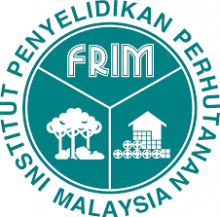
02 Aug 2010
THEME: Firefly Conservation: From Science to Practice
DATE: 2-5 August 2010
VENUE: Forest Research Institute Malaysia

26 Jul 2010
Combustion, Incineration/ Pyrolysis and Emission Control: Waste to Wealth (6th i-CIPEC - W2W 2010)

11 Jan 2010
The objective of the RIKEN Conference is to advance the physical, chemical, biological, medical, and engineering sciences and to promote practical application in these disciplines, as well as to provide an international interdisciplinary forum for discussion among scientists.

30 Jan 2010
International GCOE Symposium on Neurocognitive Development "Shedding Light on Developing Brain" is to be held as follows.
*Admission free, registration is required.
*This event will be held in English; no interpretation will be provided.

08 Mar 2010
The Graduate School of Information Science, Nagoya University, in collaboration with the Faculty of Mechanical Engineering, Universiti Teknologi MARA (UiTM), is pleased to announce the first International Symposium on
Robotics and Intelligent Sensors (IRIS2010) that will be held in Nagoya University, Japan from 8th to 11th of March 2010.

14 Dec 2009
The increasingly complex and interconnected world in which we live poses broad new challenges for science and society. Among the most important are global climate change, clean energy, population growth, sustainable food and water supplies, and the development of effective social organizations on both local and global scales.

14 Dec 2009
International Symposium on Complex Systems "Toward Sustainable Social Systems: Phase transition - Evolution - Polysemy" is to be held as follows.
* Admission free, Online registration is required.(Deadline: Friday, 11th December, 2009)
*This event will be held in English; no interpretation will be provided.
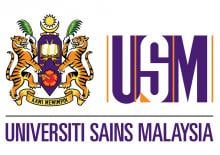
03 Nov 2009
Universiti Sains Malaysia will be hosting the The 4th International Conference On E-Commerce With Focus On Developing Countries 2009 (ECDC’09) starting from Tuesday, 3rd November 2009 at the JW Marriott Hotel in Kuala Lumpur.

14 Nov 2009
Charles Darwin is celebrated as one of the greatest scientists of all time, with his work forming the foundation of many different research fields, and yet his ideas still stir up debate. The British Council have teamed up with Bibliotheca Alexandrina to organise this international conference to explore Darwinism.

04 Nov 2009
Over the last 15 years ICTs have been increasingly and optimistically promoted as a means of transforming developing countries yet little is known about the long-term social and economic effects of these technologies upon societies both in urban and rural areas.

29 Oct 2009
Sago palm (Metroxylon spp.) is one of the major crops that contributed significantly to the economy of ASEAN. The scope of the Symposium includes the board scope in the discipline and research in sago plantation.

24 Sep 2009
Fourth Asian Semantic Web Conference (ASWC 2009)
6-9 December, 2009
Shangai, China

20 Oct 2009
TWAS, the academy of sciences for the developing world, will hold its 11th General Conference and 20th General Meeting in Durban, South Africa, on 20-23 October 2009. The conference is being hosted by the Academy of Science and Technology of South Africa and supported by South Africa's Department of Science and Technology.

08 Aug 2009
This seminar is to disseminate the latest R&D findings on the utilization of biomass for biofuel and other value-added products

08 Aug 2009
The workshop is to provide participants with theoretical insight into technologies used in genetic transformation and DNA profiling as well as hands-on experience in these two fields.

31 Jul 2010
BIT’ s 1st World Congress of Virus and Infections-2010 (WCVI-2010) will be held during July 31-August 3, 2010 in Busan, Korea, with a theme of “Voice of Virologists”.

03 Aug 2009
Singapore, July 30, 2009 – The Institute of Bioengineering and Nanotechnology (IBN), the world's first bioengineering and nanotechnology research institute, has partnered with Nano Today, a leading nanoscience and nanotechnology journal, published by Elsevier, to organize the 1st Nano Today Conference at Biopolis, Singapore from August 3-5, 2009.

16 Nov 2009
The 6th International Rice Genetics Symposium is one of the world’s biggest and most important rice research conferences. Adding to its scope and significance, this event will be held in conjunction with the 7th International Symposium on Rice Functional Genomics.

20 Nov 2009
The Universiti Sains Malaysia and the Leuphana University of Lüneburg cordially invite you to participate in the 3rd International Conference on Sustainability in Higher Education, which will take place in Penang, Malaysia on 20 – 22 November 2009.
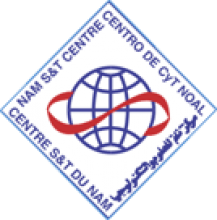
29 Sep 2009
The workshop is aimed at facilitating the sharing of information on various aspects of land degradation, exchanging the country specific information about land degradation, land use decisions and environment, seeking possibilities for cross country projects among NAM members and promoting scientist-to-scientist contact and interactions.

28 Sep 2009
Arab Science & Technology Foundation is organizing its first conference on Arab Women in Science and Technology; Empowering for the Development in the Arab World.

26 Jun 2009
The Italian Ministry of Foreign Affairs and TWAS, the academy of sciences for the developing world, are organizing a conference focusing on enhancing cultural and scientific cooperation in Afghanistan and its neighbouring countries.

23 Nov 2009
The EAS Congress is a pioneering region-wide platform for capacity building, strategic action and cooperation for the sustainable development of the Seas of East Asia.

24 Mar 2010
This Congress will present topics concerning the very current advancements in antibody research and product development.
Giants in history
Chinese biochemist Chi Che Wang (1894 - 1979), one of the first Chinese women to study abroad, advanced to prominent research positions at American institutions including the University of Chicago and the Northwestern University Medical School.
Ruby Sakae Hirose (1904 – 1960) was a Japanese-American scientist whose research contributed significantly to our understanding of blood clotting, allergies and cancer.
Chinese electron microscopy specialist Li Fanghua (6 January 1932 – 24 January 2020) facilitated the high-resolution imaging of crystal structures by eliminating interference.
Sálim Moizuddin Abdul Ali (12 November 1896 – 20 June 1987), commonly referred to as the Birdman of India, was the first person to conduct systematic surveys of birds from across India.
Haisako Koyama (1916 – 1997) was a Japanese solar observer whose dedication to recording sunspots – cooler parts of the sun’s surface that appear dark – produced a sunspot record of historic importance.
Michiaki Takahashi (17 February 1928 – 16 December 2013) was a Japanese virologist who developed the first chickenpox vaccine.
Toshiko Yuasa (11 December 1909 – 1 February 1980) was the first Japanese female physicist whose research on radioactivity shed light on beta decay – the process in which an atom emits a beta particle (electron) and turns into a different element.
Angelita Castro Kelly (1942-2015) was the first female Mission Operations Manager (MOM) of NASA. She spearheaded and supervised the Earth Observing System missions during its developmental stage.
Malaysia’s first astrophysicist, Mazlan binti Othman (born 11 December 1951) was instrumental in launching the country’s first microsatellite, and in sending Malaysia’s first astronaut, Sheikh Muszaphar Shukor, into space.
Known as Mr. Natural Rubber, chemist and researcher B. C. Shekhar (17 November 1929 – 6 September 2006) introduced a number of technical innovations that helped put Malaysia’s natural rubber industry on the world map.
Shinichiro Tomonaga (31 March 1906 – 8 July 1979), together with Richard Feynman and Julian Schwinger, was awarded the Nobel Prize in Physics in 1965, for their contributions to advance the field of quantum electrodynamics. Tomonaga was also a strong proponent of peace, who actively campaigned against the proliferation of nuclear weapons and promoted the peaceful use of nuclear energy.
South Korean theoretical physicist Daniel Chonghan Hong (3 March 1956 – 6 July 2002) achieved fame in the public sphere through his research into the physics of popcorn.
Japanese chemist Kenichi Fukui (4 October 1918 – 9 January 1998) was the first Asian scientist to be awarded the Nobel Prize in Chemistry. Together with Roald Hoffman, he received this honour in 1981 for his independent research into the mechanisms of chemical reactions.
Chinese palaeontologist, archaeologist and anthropologist Pei Wenzhong (January 19, 1904 – September 18, 1982) is regarded as a founder of Chinese anthropology.
Physicist Narinder Singh Kapany (31 October 1926 – 4 December 2020) pioneered the use of optical fibres to transmit images, and founded several optical technology companies. Born in Punjab, India, he worked at a local optical instruments factory before moving to London for PhD studies at Imperial College. There, he devised a flexible fibrescope to convey images along bundles of glass fibres.
Japanese physicist Ukichiro Nakaya (1900-1962) made the world’s first artificial snowflakes. He started his research on snow crystals in the early 1930s at Hokkaido University, where there is an unlimited supply of natural snow in winter. By taking over 3,000 photographs, he established a classification of natural snow crystals and described their relationship with weather conditions.
The field of solid-state ionics originated in Europe, but Takehiko Takahashi of Nagoya University in Japan was the first to coin the term ‘solid ionics’ in 1967. ‘Solid-state ionics’ first appeared in 1971 in another of his papers, and was likely a play on ‘solid-state electronics’, another rapidly growing field at the time.
Charles Kuen Kao (Nov. 4, 1933 to Sept. 23, 2018) was an engineer who is regarded as the father of fibre optics. His work in the 1960s on long distance signal transmission using very pure glass fibres revolutionized telecommunications, enabling innovations such as the Internet.
Chika Kuroda (24 March 1884 – 8 November 1968) was a Japanese chemist whose research focussed on the structures of natural pigments.
Motoo Kimura (13 November 1924 – 13 November 1994) was a Japanese theoretical population geneticist who is best remembered for developing the neutral theory of molecular evolution.
Meghnad Saha (6 October 1893 – 16 February 1956) was an Indian astrophysicist best known for formulating the Saha ionization equation which describes the chemical and physical properties of stars.
Sir Jagadish Chandra Bose (30 November 1858 – 23 November 1937) was a scientist and inventor who contributed to a wide range of scientific fields such as physics, botany and biology.
Osamu Shimomura (27 August 1928 – 19 October 2018) was a Japanese organic chemist and marine biologist who dedicated his career to understanding how organisms emitted light.
Subrahmanyan Chandrasekhar (19 October 1910 – 21 August 1995) was an Indian astrophysicist who studied the structure and evolution of stars.
Joo-myung Seok (November 13, 1908 – October 6, 1950) was a Korean butterfly entomologist who made important contributions to the taxonomy of the native butterfly species in Korea.
Mathematician Maryam Mirzakhani (12 May 1977 – 14 July 2017) was the first and only woman and Iranian to date to win the Fields Medal in 2014 for her work on curved surfaces.
Sir Chandrasekhara Venkata Raman (7 November 1888 – 21 November 1970) was an Indian physicist who performed ground-breaking research in the field of light-scattering.
Mohammad Abdus Salam (29 January 1926 – 21 November 1996) was a theoretical physicist and the first Pakistani to receive a Nobel Prize in science.
Srinivasa Ramanujan (22 December 1887 – 26 April 1920) was a math prodigy and widely considered one of India’s greatest mathematicians. Despite having almost no formal training in mathematics, he made substantial contributions to mathematical analysis, number theory, infinite series and continued fractions.
Gopalasamudram Narayanan Ramachandran (8 October 1922 – 7 April 2001) is best known for developing the Ramachandran plot to understand the structure of short chains of amino acids, known as peptides.
Hitoshi Kihara (1893 – 1986) was one of the most famous Japanese geneticists of the 20th century. One of his most significant contributions was identifying sex chromosomes (X and Y) in flowering plants.
Chien-Shiung Wu (31 May 1912 – 16 February 1997) was an experimental physicist who made several important contributions to nuclear physics. Wu worked on the Manhattan Project – a top-secret program for the production of nuclear weapons during World War II and helped to develop a process for separating uranium into U235 and U238.
Meemann Chang (born 17 April 1936) is a Chinese palaeontologist who studied the fossils of ancient fish to understand the evolution of life. By examining fossils, she uncovered new insights on how vertebrates, animals with a backbone, migrated from the sea and became adapted to live on land.
Bibha Chowdhuri (1913 – 2 June 1991) was an Indian physicist who researched on particle physics and cosmic rays. In 1936, she was the only female to complete a M.Sc. degree at the University of Calcutta.
Lin Lanying (7 February 1918 – 4 March 2003) was a Chinese material engineer remembered for her contributions to the field of semiconductor and aerospace materials. Lanying was born into a family who did not believe in educating girls and she was not allowed to go to school.
Japanese geochemist Katsuko Saruhashi developed the first method and tools for measuring carbon dioxide in seawater


